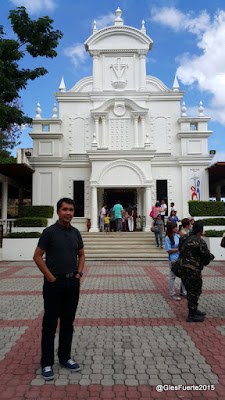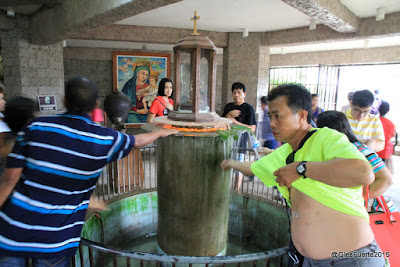Shrine of Our Lady of the Most Holy Rosary
Manaoag, Pangasinan
18 November 2015
 It was a long holiday because of the APEC in Manila. We took this opportunity to unwind, escaped the city and traveled north.
It was a long holiday because of the APEC in Manila. We took this opportunity to unwind, escaped the city and traveled north.Our destination was the "pilgrim center of the north" in Manaoag, Pangasinan province (The Shrine of Our Lady of the Most Holy Rosary of Manaoag). It was my second time to visit the church after almost ten years.
We left Manila at 0700H on the 18th of November 2015. We were five - Dr. NRV, Ms. Weng, Jeannie, Rhea and myself. We were aiming to attend the 1000H mass.
We took the Mindanao Avenue, NLEX and then TPLEX. We were so confident that we can attend the said mass since travel time to Manaoag from Manila via TPLEX would normally take two and a half hours only, according to Ms. Rhea who frequently visits the site.
We took the Mindanao Avenue, NLEX and then TPLEX. We were so confident that we can attend the said mass since travel time to Manaoag from Manila via TPLEX would normally take two and a half hours only, according to Ms. Rhea who frequently visits the site.
We never thought and underestimated the volume of vehicles going out of Manila and travelling north at that time. Not to mention, there were several vehicular accidents along TPLEX and so instead of two and a half hours normal travel time to Manaog, it took us more than five hours to reach the pilgrim site.
While on a heavy traffic along the express way, we had fun inside the car. We had a game called "Around the World" inside the care. I could not believe that there was such a heavy traffic on an express way like TPLEX.
At 1215H, we were queuing at the church parking lot. Though the 1000H mass celebration was over, the church was still full at that time including the parking area.
I started exploring the church at 1246H. Except for the image of the Blessed Virgin Mary, I could no longer recall the structural feature of the church when I first visited the site.
I had an expectation to see an old colonial church similar to those in the Ilocos provinces, however, the present architecture of the church, for me, looked completely new.
It could be due to the several restorations done on the structure that made it looked a modern infrastructure.
It could be due to the several restorations done on the structure that made it looked a modern infrastructure.
Nevertheless, I had a good time exploring the site.
The center of the pilgrim site is the image of the Blessed Virgin Mary with the Child Jesus enshrined at the high altar of the Basilica.
According to Wikipedia, The statue of Our Lady of Manaoag is a 17th-century ivory image of the Virgin Mary with the Child Jesus enshrined at the high altar of the Basilica. It was brought to the Philippines from Spain via the Manila galleon from Acapulco, Viceroyalty of New Mexico, in the early 17th century by the priest Juan de San Jacinto.
Documents dating back to 1610 attest that a middle-aged farmer walking home heard a mysterious female voice. He looked around and saw on a cloud-veiled treetop an apparition of the Virgin Mary, holding a rosary in her right hand and the Child Jesus in her left arm, all amidst a heavenly glow. Mary told the farmer where she wanted her church to be built, and a chapel was built on the hilltop site of the apparition, forming the nucleus of the present town.
Our Lady of the Rosary is depicted in other countries with similar attributes, with the accouterments and style of the vestments varying across cultures. The Manaoag image is distinct from other statues in its sculpture and regalia, particularly its crown.
A pilgrim replica of the image also exists and is toured around parishes in the Philippines for veneration.
The image of Our Lady of Manaoag and her bejeweled crown are considered priceless. There have been several attempts to burglaries the Manaoag Shrine of the jewels sewn into the icon's dress and set into its regalia which include crowns, halos, rosary, scepters, and marshal's baton.
Several of her golden crowns and halos are deposited at the shrine's museum, donated by both local and foreign devotees. An expensive collection of liturgical vestments that have been used by the image and the Dominican priests are also on display, as are an array of perfumes used to anoint the image. These are ex-votos given by devotees and pilgrims from around the world.
The image of Our Lady of Manaoag is fully secured within a bulletproof glass enclosure above the new high altar, which has additional wood carvings, an elevated pedestal, and four golden candelabras. The coat-of-arms of the Dominicans is embedded above the image's window as a demonstration of the Order's devotion to her. The bas-relief, made of narra carvings beneath her throne that beautifully depicts the historic events in the devotion to Our Lady, has been refurbished.
The archdiocese, in line with the Filipino custom of venerated an image by touching its body or clothing, constructed a staircase that rises to Veneration Room on the second floor behind the apse. The room has pews in front of the alcove behind the image's shrine. Supplicants kneel before the glass small window behind the image's base to pray and touch the hem of the image's mantle, often dropping written prayers into a nearby box. After venerating the image, devotees pass through the religious goods shop on their way out.
--o0o--
Monasterio de Tarlac
San Jose, Tarlac
8 December 2015
 We had a Town Hall meeting at our Subic Branch office on the 7th of December 2015.
We had a Town Hall meeting at our Subic Branch office on the 7th of December 2015.The following day while driving along SCTEX, we decided to visit the Monasterio de Tarlac on our way back to Manila.
According to WikiPedia, Monasterio de Tarlac is a popular tourist destination in the province of Tarlac in the Philippines. It is a monastery on top of Mount Resurrection, part of the Zambales Mountain Range in San Jose, one of the municipalites in Tarlac.
In the monastery can be found a relic of the True Cross. Monasterio de Tarlac is located at the Mount Resurrection Eco Park in barangay Lubigan.
In the monastery can be found a relic of the True Cross. Monasterio de Tarlac is located at the Mount Resurrection Eco Park in barangay Lubigan.
There is no entrance fee to the monastery and it is open to the public daily from 7:00AM to 6:00PM.
The Monasterio de Tarlac covers 278-hectare Ecotourism Park which was developed by the former congressman Jose "APING" Yap. It is surrounded by nature with natural and fresh air coming from the mountain. A 30-foot colossal statue of Jesus Christ overseeing the city stands tall at the side of the mountain.
We left Subic office after having a sumptuous breakfast at the hotel at 0730H and took SCTEX. Five of us were on board Jeannie's car. From SCTEX, we took Mabalacat Exit and then drove along Manila North Road (McArthur Highway) and then exit at Capas then straight ahead to the site.
We had few minutes stop over at Mabalacat Shell station for a quick break and to refuel.
The road leading to the site is a long winding road. I felt like traveling along the zigzag road at Dalton Pass.
We reached the site atop the hill at San Jose Tarlac 1045H. There was a mass at 1100H which we all attended.
One of the many highlights of our visit to the Monasterio was our experience to touch the case containing the relic of the True Cross. The golden case is inside the church altar.
Aside from the relic of the True Cross, we were so happy to see the 30-foot statue of Jesus Christ overlooking the city similar to the the statue of Christ the Redeemer in Brazil.
After taking photos, we left the Monasterio de Tarlac with a happy and fulfilled hearts at 1300H
--o0o--
Shrine of St. Padre Pio
Sto. Tomas, Batangas
20 December 2015
 For several times, I had seen the Shrine of St. Padre Pio featured on numerous blog sites and tourist leaflets.
For several times, I had seen the Shrine of St. Padre Pio featured on numerous blog sites and tourist leaflets.I had been planning to see the Shrine several months ago.
Early on the 28th of December 2015, Jeannie and I met at the Cash and Carry Mall and then proceeded to Dr. NRV's place in Paranaque.
From Paranaque, on board NRV's vehicle, we traveled south and fetched Ms. Weng and Rhea at Robinson's Pala Pala. From there we went straight to Sto. Tomas in Batangas. Melanie was waiting for us somewhere along the Star Express Way.
From Paranaque, on board NRV's vehicle, we traveled south and fetched Ms. Weng and Rhea at Robinson's Pala Pala. From there we went straight to Sto. Tomas in Batangas. Melanie was waiting for us somewhere along the Star Express Way.
We were hoping to attend the 1000H mass celebration at the Shrine. Luckily, we reached the site at 0945H few minutes before the mass started.
It was my first time at the Shrine. Upon entering the site, I was immediately impressed looking at the circular church structure with a dome.
Jesus Christ statue hangs at the middle of the dome while the Blessed Virgin Mary stands tall at the top of the dome.
Jesus Christ statue hangs at the middle of the dome while the Blessed Virgin Mary stands tall at the top of the dome.
Nearby the church is an hexagonal structure that serves as the bell tower.
Under the bell tower is a holy water fountain.
I had the chance to climb up the bell tower and took a photo of the church from above.
Under the bell tower is a holy water fountain.
I had the chance to climb up the bell tower and took a photo of the church from above.
The church is surrounded with different status of saints.
At the rear of the church is another cross of Jesus Christ with St. Padre Pio.
The candelaria can also be found at the rear of the church.
The candelaria can also be found at the rear of the church.
I felt blessed and happy to be able to see the Shrine finally and for the first time.
We left the Shrine at 1300H.
--o0o--






















No comments:
Post a Comment